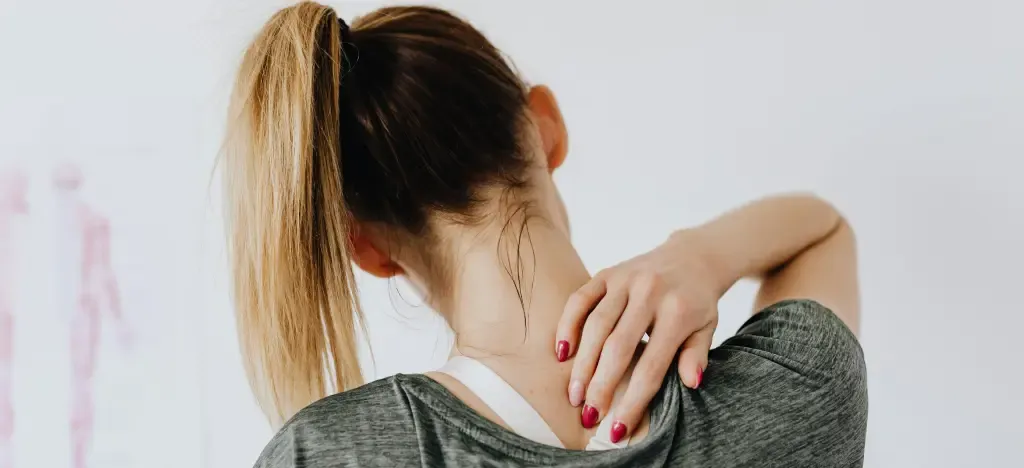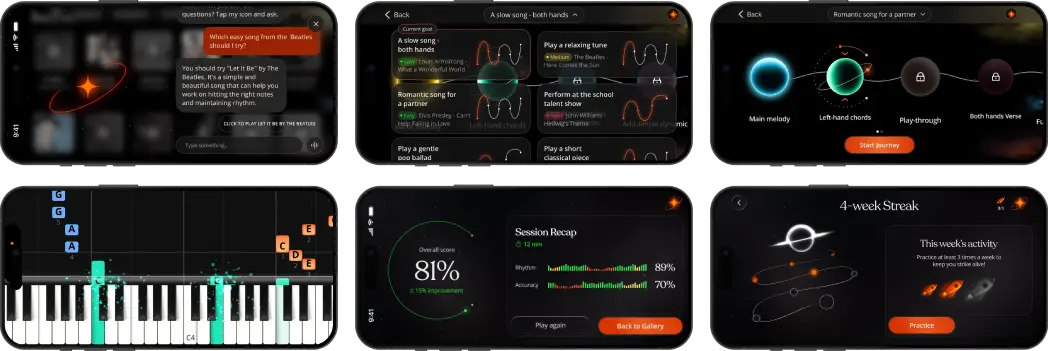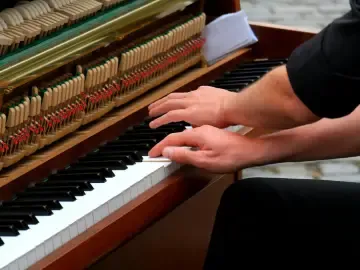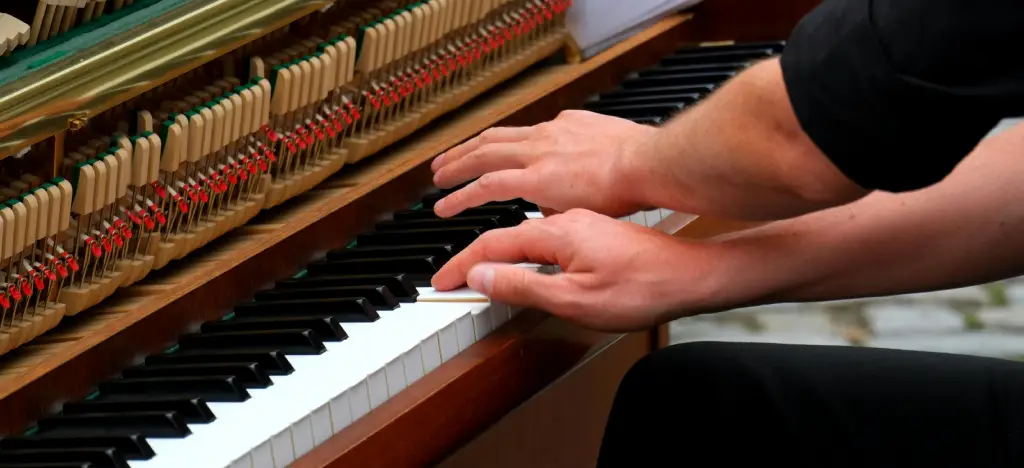It’s not something most beginners think about when they sit down to play. You're more likely focused on finding the right notes than on how hard you're actually pressing them. But here's the thing: your touch — how you connect with the keys — speaks volumes about your technique, your musicality, and even your future progress.
In this article, we’ll look at what touch really means, why pressing too hard is so common, and how you can improve your control through simple tests and practical exercises.
- What do we mean by piano “touch”?
- What the research says about finger pressure
- Signs you’re pressing the piano keys too hard
- How professional pianists develop touch
- A quick self-check: is your touch expressive or heavy-handed?
- Practical exercises to improve your piano touch
- Other ways to improve your touch
- Want real feedback on your touch?
- FAQs about piano touch
What do we mean by piano “touch”?
In piano playing, “touch” refers to how you physically interact with the keys. It’s about pressure, but also finesse. The speed and depth of each keystroke, the way your hand transfers weight, the subtle lift at the end of a phrase — these elements combine to form the character of your sound. It includes:
Finger pressure (how much force is applied)
Timing of release (how long you hold each note)
Arm weight (how the whole body supports playing)
Wrist flexibility (crucial for control and phrasing)
You can play the exact same note with two different touches and produce two very different effects. One could be lyrical and singing, the other could sound flat and forced. The piano, though mechanical, is highly sensitive to input. It responds not just to what you play, but to how you play it.
💡 ARTMASTER TIP: Touch is one part of sounding more expressive — but there’s more to explore. If you want to know how the pros shape their sound beyond just finger pressure, check out 10 advanced piano tips to transform your playing.
What the research says about finger pressure
 Studies on piano biomechanics (e.g. Furuya & Kinoshita, 2007) show that:
Studies on piano biomechanics (e.g. Furuya & Kinoshita, 2007) show that:
Beginners often use excessive finger force, especially when trying to play louder or more confidently.
Experienced players use less force but with more precision — letting gravity and body weight do the work, not muscle tension.
Finger pressure varies based on intent. Legato requires different touch than staccato, and loud doesn’t mean heavy-handed.
Interestingly, research from Tokyo University showed that many students use 30–50% more pressure than necessary to trigger key response. That’s not just inefficient — it builds fatigue, reinforces bad habits, and kills nuance.
Signs you’re pressing the piano keys too hard
 You may not even realise it’s happening, but here are some red flags:
You may not even realise it’s happening, but here are some red flags:
You feel tension in your forearms or shoulders after playing
Your soft passages still sound loud and harsh
Your dynamics feel flat — everything sounds the same
You rely on the pedal to smooth things out
You hear a mechanical "thud" at the bottom of each keystroke
It’s less about bad habits and more about undeveloped control — a detail often missed in traditional lessons.
💡 ARTMASTER TIP: Realising you’re pressing too hard is actually a good sign — it means you’re paying attention. If you want more straightforward advice ttry our Essential tips for learning piano with practical tips for busy adults.
How professional pianists develop touch
Great pianists aren’t born with perfect touch. They develop it, often over years of practice and with the help of sensitive teachers who notice the subtlest imbalance. They also build an intuitive connection between what they hear and how they feel — something that takes time.
Rather than pressing harder, they focus on:
Wrist flexibility and relaxed movement
Letting the arm's weight do the work (not just finger strength)
Carefully listening to dynamic balance between hands
Feeling the resistance of the key and working with it, not against it
Approaches like the Taubman technique and Alexander Technique — both used by elite pianists — emphasise injury-free movement and expressive touch over muscular effort.
💡 ARTMASTER TIP: Want your playing to sound more polished and expressive? Piano: Sound Like a Pro by professional pianist David Bennett (Abbey Road) teaches you how — with simple techniques for improving your touch, phrasing, and chord tone. It’s all about how you play, not just what you play.
A quick self-check: is your touch expressive or heavy-handed?
Here are three simple tests you can do at your piano to check how much control you really have over your touch.
1. Even tone test
Play five notes in a row, slowly and smoothly — like a little musical ladder going up or down. Aim to keep each note the same volume. Listen carefully:
Are some notes louder than others?
Do any “jump out” unexpectedly?
This reveals how evenly you’re pressing the keys — a key part of dynamic control.
2. Whisper note challenge
Choose one key and play it as softly as you can while still making a sound. Try to go quieter with each repeat.
Can you keep the tone clear?
Or does the note disappear or feel awkward to control?
This shows how sensitive your fingers are — and whether you're relying on force instead of finesse.
3. Loud-soft-loud test
Play a simple melody (even just three or four notes), and deliberately vary the volume: start loud, go soft in the middle, then build back to loud.
Does the contrast come through?
Or do you find yourself slipping back to one default volume?
If this feels difficult or inconsistent, that’s normal. It means your fingers are still developing the coordination to shape the sound — and that’s something you can absolutely improve with focused practice.
Practical exercises to improve your piano touch
 If you’ve realised your playing feels stiff, too loud, or one-dimensional, the good news is this: touch can be trained. Gaining control over finger pressure and dynamic range doesn’t require hours a day — it just needs focused, thoughtful practice. Here are a few exercises that actually work.
If you’ve realised your playing feels stiff, too loud, or one-dimensional, the good news is this: touch can be trained. Gaining control over finger pressure and dynamic range doesn’t require hours a day — it just needs focused, thoughtful practice. Here are a few exercises that actually work.
Weighted key drops
Sit with your hand relaxed above the keyboard. Let your arm fall naturally, using gravity to press a key — don’t push with your fingers. You should feel the key respond smoothly, not with a jab.
Try this with each finger, one at a time.
The goal is effortless motion, not volume.
It helps you use arm weight instead of muscular tension.
This is how many professionals develop tone — letting the piano do more of the work.
Dynamic contrast scales
Play a simple C major scale, two octaves if you can. Start quietly and gradually increase the volume as you ascend. Then reverse it coming down — louder at the top, fading as you go lower.
Listen for smooth, consistent changes in volume.
Avoid sudden jumps or accidental accents.
Repeat in reverse — soft to loud descending.
This trains fine motor control and your ear at the same time.
One-finger singing tone
Choose a melody note (any note) and play it repeatedly with a single finger. Try to make it sing, not bark. Focus on how you press and release the key. Then try shaping the volume: start softly, build, fade.
It’s not about speed — go slowly and listen.
This helps you develop a more expressive, controlled touch with each finger.
Repeat with all five fingers, even the weaker ones.
Silent key depressions
Without making a sound, gently press a key down until it reaches the point of resistance just before it sounds. Hold it there, then slowly release.
This teaches you where the key begins to respond.
It’s a great way to build finger sensitivity and reduce unnecessary tension.
You’ll learn to press only as much as you need — no more, no less.
Quiet left hand, singing right hand
This is one exercise I have been practising a lot recently. Play a simple two-hand chord or phrase. Focus on making your right hand sing while your left hand stays in the background.
This is surprisingly hard at first.
It trains independence of touch, not just rhythm.
Start with short phrases, then work up to longer sections.
This is a staple exercise for expressive control in real music.
💡 ARTMASTER TIP: Refining your touch isn’t just about the right exercises — it’s also about how you practise. If you want to make your practice time more focused and effective, check out The art of effective music practice. It’s full of practical strategies to help you make real progress
Other ways to improve your touch
Improving your piano touch isn’t just about finger exercises — it’s also about how you practise, what you listen to, and the habits you build around playing. These approaches can make just as much difference as time at the keys.
Slow practice with intention
Slowing down forces you to listen. It reveals uneven tone, accidental accents, and stiffness you might not notice at full speed. When you practise slowly with focus — shaping each note, listening to your tone — your touch becomes more deliberate and musical.
Record yourself (often)
What feels expressive in your fingers can sound heavy or flat when played back. Recording helps you develop a more objective ear. Pay attention to whether your soft notes are truly soft, and whether your phrasing has shape. You’ll hear things you didn’t catch in the moment.
Listen to great pianists
Spend time with players who are known for their tone — not just their speed. Think of Maria João Pires, Alfred Brendel, or Bill Evans. Notice how much they don’t do — how they use space, subtle changes in pressure, and contrast. Your ear is your best teacher.
Play more acoustic piano
Digital pianos can mask bad habits — some don’t fully respond to subtle changes in touch. If possible, practise regularly on an acoustic. It forces you to develop better control and gives more honest feedback. Even 15 minutes at a real piano can sharpen your awareness.
Take breaks
It might sound counterintuitive, but breaks improve control. Tension builds when we push through fatigue. If your wrists or shoulders tighten, stop. Walk away. Play again with relaxed hands. A fresh start often brings better touch.
💡 ARTMASTER TIP: These habits won’t change everything overnight — but touch is about awareness. The more you listen, reflect, and play with care, the more control you’ll gain. It’s a quieter kind of progress, but it’s the one that makes people stop and really listen.
Want real feedback on your touch?
 You can get a long way on your own — through focused exercises, slow practice, and careful listening. But improving your touch is one of those things that benefits hugely from good feedback. Ideally, from someone — or something — that can actually hear the details you might miss.
You can get a long way on your own — through focused exercises, slow practice, and careful listening. But improving your touch is one of those things that benefits hugely from good feedback. Ideally, from someone — or something — that can actually hear the details you might miss.
Working with a teacher is one of the best ways to develop expressive, controlled playing. A skilled teacher can spot tension, point out uneven dynamics, and guide you toward a more musical sound.
But not everyone has regular access to one. That’s why we’re building Artie — an AI piano teacher designed to listen like a real one. He doesn’t just check if you played the right notes. He listens for:
Uneven finger pressure
Flat dynamics
Imbalances between your hands
Over-reliance on force instead of finesse
Download Artie for free now
Whether you're working on your own, with a teacher, or somewhere in between — your touch matters. We're building something to help you hear it more clearly.
FAQs about piano touch
How do I know if I’m pressing piano keys too hard?
You might notice tension in your arms or shoulders, harsh or flat dynamics, or a dull thud at the bottom of each keystroke. These are common signs that you're using more pressure than necessary — often without realising it.
Can pressing too hard damage a digital piano?
Most digital pianos can handle heavy playing, but excessive force can wear out lower-quality key mechanisms over time. More importantly, it reinforces bad habits that limit your control and increase the risk of tension or injury.
Why do beginners press too hard?
It’s usually a combination of tension and trying too hard to control volume. Without developed touch, beginners often use force instead of finesse — especially when trying to play confidently or expressively.
What’s the best way to improve piano touch?
Start with slow, intentional practice. Use exercises that focus on arm weight, dynamic control, and finger sensitivity. Recording yourself and listening back also helps you hear when your touch is uneven or heavy.
Can an AI teacher help with piano touch?
Yes. Artie, ArtMaster’s AI teacher, gives real-time feedback on pressure, balance, and dynamics. He can hear things you might miss, helping you build better technique even if you don’t have a human teacher.
About the author
Matt Ford is a musician, teacher, writer, and lifelong student of sound.
With years of experience in both performing and teaching, he shares practical advice through ArtMaster to help musicians at every level build skill and confidence in their playing.

